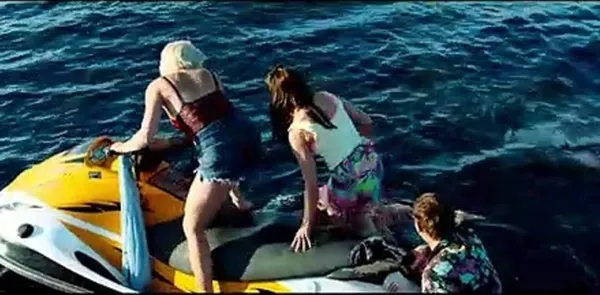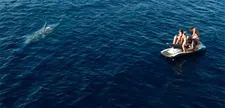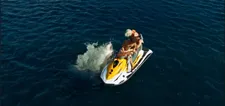 |
| Shark Bait |
Five young people, two illicitly borrowed jetskis, one hungry predator. James Nunn’s ocean-set thriller Shark Bait is in US cinemas now, making the water feel distinctly unsafe, and on the day of its release I had the opportunity to chat to the director about the challenges he faced on a truly gruelling shoot. It’s a film which opens with a handsomely designed tracking shot across a dark and shadowy reef, the camera then pulling up to a beach where there is fire and music and young people dancing. It’s a nice nod to the opening of Jaws, I put it to him.
“You got me!” he laughs. “Yes, I suppose it was actually. I wanted to do something unique for the opening, and something that felt like it set the tone for the movie, but also felt bigger than the sum of the parts, because we were operating in a low budget space. And I just thought, well, if I never get to do that kind of camera going from the water to the air at any other point in the movie, at least if I opened with it people will be like, ‘Oh, wow, they had some money to make it look good. So I never thought I'd even get it, and I turned to one of the producers, Simon [Sansone], and I pitched the idea at him and he just sort of went ‘Yeah, okay’. And I thought, ‘What? Like, you're going to do this?’ So yes, it was a it was a hybrid of paying homage to Jaws and then also trying to do something that really felt like the movie was elevated and take us into our world.”
So when one is brought on board for a shark film, how does one go about making it one’s own?
“I was very fortunate about five or six years ago to do some second unit director work on the 47 Metres Down franchise,” he says. “And then there's a producer in England called Andrew Prendergast, who was developing a shark script with the writer Nick Saltrese, and I think they thought ‘Oh, well, James knows how to shoot something on the water so let's approach him and see if we can make a package work to get it to market, and that's what happened. And then I got sent the script. And the thing with shark movies is, like, how do they get out on the water? Because once we're out on the water, you kind of know what's going to happen. And I thought that what Nick had done with the jetski was a really fun way to get these five characters out there and a fun set-up.
 |
| Shark Bait |
“I kind of liked that there was like a survival thriller drama to it. Even if there wasn't a shark in the movie, there was still a movie to make. So there was this kind of blanket of safety because you never know how good the shark is going to be or how much visual effects you can afford to make the shark good. And one of the things that I took away from Nick's script at the beginning was that there was this thriller, and there was a way to do it without seeing much shark, and feel comfortable with that. And then if we could afford it, there was another movie which felt kind of big and sexy and sharky. It felt like a kind of slasher on the ocean – more akin to Jaws 2 than Jaws 1, if we're being honest, with a bunch of teams being chased around by a murderous shark.”
I tell him that I liked the fact that there isn't much shark in it for a while, because that gives him time to build up a sense of threat and an awareness that they're in danger in the ocean, as he says, even if there isn't a shark there.
“I think you’ve got to hold back as long as you can. Everyone's expecting the shark, you know – the movie’s called Shark Bait. It's kind of about playing a little bit to that as well. If we showed the shark in the first five minutes, you'd be like, ‘Oh, okay, well now we’ve seen the shark.’ We’re trying to build up the drama and tension and character world for those 20 to 25 minutes until we first see the shark. Hopefully, by that point, you're invested enough in the situation and the characters to be like, ‘Okay, yeah, cool. I'm on this ride.’ And now with the shark involved, we know what's going to happen.”
I also liked the fact that the shark isn’t just a sort of killing machine. We see it as an animal, and there's something more interesting going on, psychologically, with that.
“I approach every project from a very technical and realism perspective, the kind of director I am and the kind of movies I like to make,” he says. “And it was always important to me that the shark had this realism to it, because I think it goes for all stories in life. Often truth is more interesting and amazing than fiction. And I think if you just have these monster sharks, people are removed a bit from it, because they just see it as this, well, not human, alien villain or monster. So we really were trying to create a realistic side to this shark and like, the predatory behaviour of the shark.
“I suppose a lot of people would call this a horror film. I would call it a thriller film, like Silence Of The Lambs. That, to me is a thriller film, but a lot of people think it’s a horror film. I suppose what we were trying to make with Shark Bait was like, we were trying to move through the film and then have our jumping scares that you kind of need in the film, but hopefully there's more to it and there's more to the shark amongst them.”
How did he approach that from a technical point of view, with the underwater shooting and then building effects into it?
 |
| Shark Bait |
“Obviously the script had certain things written into it, so you've got that base level of the writers idea of what it should be. And then you put in the research from watching a lot of documentaries, watching a lot of good shark movies. I would take inspiration from something like The Reef, I thought the tension that they created with those four people just in the water with the shark was really, really expertly done for, you know, not a lot of money. So there was taking elements of what works in there, and then to get these kind of movie made, because you need to be able to demonstrate to people how you're going to do it, you need to get VFX quotes and stuff, and sequences were actually storyboarded eight months before they were ever shot so that the storyboards can go to the VFX company and they can work out what can they do, what can't they do, and what things we need to build to be able to do those things.
“So that's all part of the process. And then then you're shooting a bit off of the storyboard. When you go to actually shoot the movie, you're obviously trying to commit to the frames that you've already committed to, but there's obviously there's there's going to be some wiggle room because not everything always translates when you get to the edit, and then they really look at the movie and they say, ‘We can do this, we can do this.’ And then you get to design the shark, which they call ‘the asset.’ You work on the shark’s scars, you know, give it a bit of a story. So we purposely damaged the side of its mouth as if it had had a hook in its mouth at some point in its life. I looked into mating scars, and we've got some mating scars on the shark and like other things like that.”
I mention that I interviewed Scott Adkins about a film they recently made together, One Shot, and Scott told me quite a bit about James’ process on that. How different it is when working in water?
“Yeah, good question. Well, it all starts in here,” he says, tapping his head. “And then it's like, ‘How do I get that onto the screen?’ The process was kind of similar with both of those movies, weirdly. For this one I rehearsed with the actors in waist deep water outside the front of the hotel for four days. I had a GoPro and I just was with my DP working out angles and fun stuff that we could do. So you've got your storyboard but then you kind of evolve that into almost like a practice shoot...I think after two or three days, you kind of establish a style and a rhythm for what the movie is becoming and what the ultimate tone and style of the piece is going to be.
“I had a fantastic camera team, both in out of the water and in the water, and a very experienced DoP, Ben Moulden, who did the dry stuff. And Mark Silk, he did the wet stuff. They both bring their own skills to it. I think a lot of a lot of action directing is very technical things. Because it can be dangerous, you know: you have to think about that wire attached to someone or pulling them across the water, so I do a lot of my best thinking in pre-production. And then once you communicate that and you get on set and you actually do it, you just try to make it as smooth as possible.”
He apologises for rambling and I tell him not to worry. We discuss the physical challenges of the shoot, and how he went about finding stars who could essentially handle acting and stunt work at the same time.
 |
| Shark Bait poster |
“I'm in a very fortunate position in that I had done some assistant directing and second unit directing on 47 Metres Down, and so knowing how to shoot that kind of movie was really beneficial going into the casting process of Shark Bait because I think we got about 500 tapes – everyone was at home recording tapes because of the pandemic – which I managed to whittle down to about ten of each character. And then casting time was extremely limited, and we brought in six of each of those ten to actually meet, and as soon as they sat down, before they even started the actual audition. I would say ‘Look, what's your level of swimming ability? There's no wrong answers Tell me, because we need to know so that we can actually make this work. Like, do you need swimming lessons? Do you need underwater breathing lessons? Do you need factor 100 sunscreen?’
“So I was able to know this before shooting on the ocean, which is predominantly what we did, and the movie is really gruelling. It's actually an adventure. It's its own thing, let alone having to think about performance like you just said. So I basically set out to find a cast that could not only to do the line in the audition, but also were very up for like the challenge of this show. And, you know, were going to be comfortable with being on the water for eight hours a day being battered by the elements and actually kind of get a kick out of it and find it fun.
“I think we found a really nice cast that really embraced that adventure and challenge. And so knowing that that was what was going to happen, as I said, we rehearsed in two to three feet of water and we ran the whole movie every day for like four days so that they really understood and they knew their lines, so that once I threw them into these action situations or these really uncontrollable situations on the water, they had the words as second nature and it was already locked into their brain that they were doing this hybrid thing.”
The star who stood out to me particularly was Holly Earl. She has the most to do as an actor but she doesn't look as muscular and physical as the other characters. So that seemed to me to be a difficult balance to have the right person in that role, with the necessary physical endurance..
“Yeah, of course. I mean, Holly's character, Nat, was really the centrepiece of the movie. She's the one with the most fulfilled arc. Arguably the other four there to kind of get eaten a bit. So it was really important to find a very strong actress for that role. And honestly, Holly’s take was incredible. When we met she was incredible. It was just never going to be anybody else. And she not only is a fantastic actress, she's also a fantastic physical performer, she can do all of that stuff. She could just look this way and sell a moment and a beat, which is amazing. But then also, she was 100% the best jetski driver of the five of them. She's definitely the next Lara Croft.”
So how does one keep everybody motivated on a set like that?
“Oh, we all became pirates!” he declares. “With a film set, it's always about camaraderie. Everybody needs to be on their game. We were out on the ocean. There was something like 35 to 50 people on the boat. Everybody's role was really valuable. It wasn't like people were being brought along just to sit around. So everybody had a role to play. And I think because of that, everybody just bonded really well. Everybody was just like on it, doing their job. And equally like this was probably one of the first movies shot after that first Covid lockdown. We had the first three months of lockdown and then we were lucky enough to be set up with the movie ready to go. So everyone had just been sitting around for three months not working. As soon as there was this job, everyone was like, ‘Oh, we're working again!’ and were so excited.”
He’s also excited about future projects, though he can’t reveal much as yet.
“Yes – I’m circling a lot of things at the minute, if you’ll pardon the shark pun. I've got some action stuff in the pipeline which should hopefully be shooting before the end of the year. I’m very excited about that. So staying in the action thriller space, and who knows, maybe a Shark Bait 2 one day.”
Shark Bait is in US cinemas now and will be released on DVD, on Altitude.film and other digital platforms from 6 June.





















